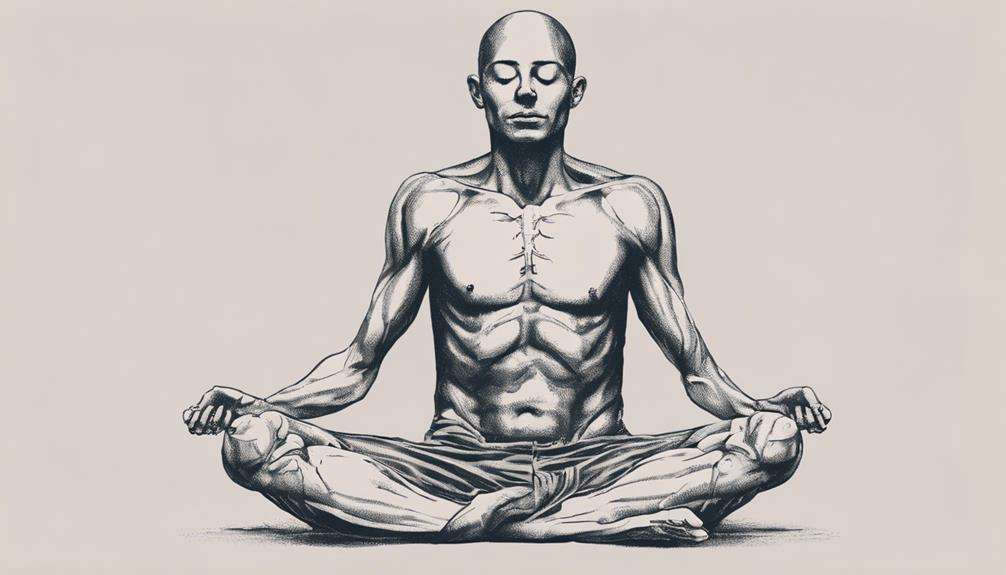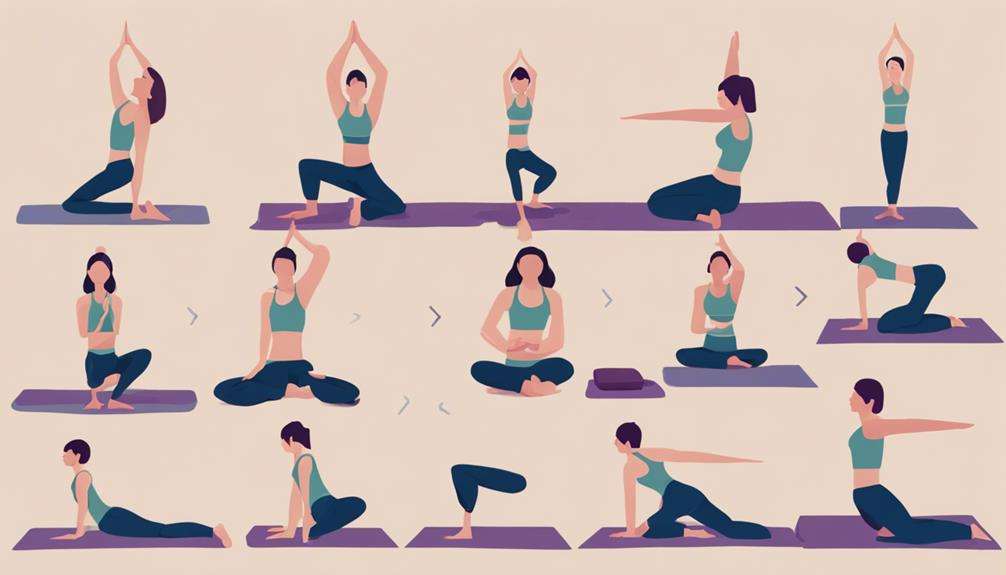Imagine your lungs as a balloon, capable of expanding and contracting with ease. Just like a balloon needs proper handling to maintain its elasticity, your lungs require care to enhance their capacity.
By implementing seven simple breathing tips, you can vitalize the potential of your lungs and improve your overall well-being.
These strategies offer a path to better lung health and vitality, empowering you to take charge of your respiratory wellness.
Key Takeaways
- Diaphragmatic breathing and yoga poses enhance lung capacity and promote respiratory health.
- Deep breathing techniques aid in stress reduction and relaxation, improving overall well-being.
- Lung-expansion poses like Cobra and Fish enhance oxygen intake and respiratory efficiency.
- Mindful breathing practices reduce stress, increase lung capacity, and improve respiratory function.
Importance of Proper Breathing Techniques
Proper breathing techniques are essential for optimizing oxygen intake and enhancing lung function. By focusing on diaphragmatic breathing, you can improve airflow and promote lung expansion. This technique allows the diaphragm to fully engage, maximizing the amount of air entering the lungs. Deep breathing not only aids in relaxation and stress reduction but also plays a vital role in enhancing overall well-being. When you breathe correctly, you support efficient oxygen exchange and the release of carbon dioxide in the lungs. Consistent practice of proper breathing methods can lead to an increase in lung capacity and contribute to better respiratory health.
Understanding the significance of breathing in relation to lung function is key to maintaining a healthy respiratory system. By incorporating diaphragmatic breathing and deep breathing techniques into your daily routine, you can positively impact your lung capacity and overall respiratory well-being. Remember, the way you breathe directly affects how your lungs function and the level of oxygen your body receives. Prioritizing proper breathing habits is a fundamental step towards improving your respiratory health.
Yoga Poses for Lung Expansion
When practicing yoga, incorporating lung expansion poses like Cobra and Bridge can enhance your lung capacity.
Poses such as Cat-Cow and Fish can also aid in improving lung expansion and flexibility.
Breathing Techniques in Yoga
Enhance your lung capacity and respiratory health through specific breathing techniques incorporated into various yoga poses. Yoga offers a range of benefits for lung expansion and overall well-being. Here's how yoga breathing techniques can help:
- Cobra Pose and Bridge Pose: Expand the chest and improve lung capacity.
- Pranayama Techniques: Try Kapalabhati and Anulom Vilom for controlled breathing and enhanced lung health.
- Deep Belly Breathing: Encouraged in yoga, it boosts oxygen intake and strengthens respiratory muscles.
Incorporating these techniques into your yoga practice can lead to increased lung efficiency, better respiratory health, and a sense of overall wellness. Explore these methods to experience the benefits firsthand.
Benefits of Lung Poses
Incorporating lung-expanding yoga poses into your routine can greatly improve your chest expansion and overall lung capacity. Yoga poses like Cobra, Camel, and Fish specifically target the chest muscles, helping to expand the chest and enhance lung capacity.
These poses work to open up the lungs, allowing for better oxygen intake and improved respiratory efficiency. By regularly practicing lung-expanding yoga poses, you can potentially reduce the risk of respiratory issues and promote better lung health.
Enhancing lung capacity through these specific yoga poses contributes to overall well-being and may aid in maintaining healthy respiratory function. Consider adding these beneficial lung poses to your yoga practice to support your lung health and optimize your respiratory system.
Meditation for Enhanced Lung Capacity

Practicing meditation techniques such as 4-7-8 breathing can greatly boost your lung capacity by facilitating deep, rhythmic breathing patterns. Meditation plays an important role in enhancing lung efficiency and overall respiratory well-being. Here's how meditation can help improve your lung capacity:
- Stress Reduction: Regular meditation practice helps reduce stress and anxiety, which in turn positively impacts lung health and function.
- Relaxation: Meditation aids in relaxation, reducing tension in the body and allowing for improved breathing patterns.
- Improved Oxygen Intake: Deep breathing during meditation sessions supports better oxygen intake, leading to enhanced lung efficiency.
Incorporating meditation into your daily routine can have a significant impact on your lung capacity and respiratory health. By focusing on deep breathing techniques like 4-7-8 breathing, you can promote relaxation, reduce stress, and improve your overall well-being. Start integrating meditation into your daily schedule to experience the benefits it can bring to your lung health.
Breathing Exercises to Strengthen Lungs
Engage your diaphragm muscle through diaphragmatic breathing to strengthen your lungs and improve lung capacity efficiently. Diaphragmatic breathing involves contracting the diaphragm downwards, allowing the lungs to expand fully and fill with air. This technique optimizes oxygen intake and helps enhance overall lung function.
Another beneficial exercise is pursed-lips breathing, where you inhale slowly through your nose and exhale through pursed lips. This method helps regulate breathing, keeping airways open for improved oxygenation and carbon dioxide removal.
Numbered breathing and 4-7-8 breathing are additional exercises that can boost lung capacity and promote relaxation. Numbered breathing involves inhaling for a specific count, holding the breath, and then exhaling for the same count. The 4-7-8 technique consists of inhaling for 4 seconds, holding for 7 seconds, and exhaling for 8 seconds. These exercises not only strengthen the lungs but also aid in calming the mind.
Mindful Breathing Practices for Wellness

When it comes to enhancing your wellness through mindful breathing, focusing on breath awareness techniques, deep belly breathing, and relaxation through controlled breath can be highly beneficial.
These practices aim to improve lung capacity, reduce stress levels, and strengthen respiratory muscles.
Breath Awareness Techniques
Enhance your breath awareness and promote relaxation through mindful breathing practices that focus on being present in the moment while paying attention to your breath. Mindful breathing techniques are powerful tools for stress reduction, increasing mindfulness, and improving lung capacity. By incorporating these practices into your daily routine, you can experience a range of benefits for your overall well-being.
- Reduce stress and anxiety levels
- Improve focus and concentration
- Enhance mindfulness and self-awareness
Deep Belly Breathing
To deepen your breath awareness and enhance wellness, practice deep belly breathing – a technique that involves engaging the diaphragm muscle to expand your lungs fully.
Deep belly breathing, also known as diaphragmatic breathing, is beneficial for your lungs as it allows for a greater oxygen intake and can help reduce stress levels. By mastering this technique, you can enhance your lung capacity, leading to improved overall respiratory function.
This mindful breathing practice focuses on filling your lungs with air by breathing deeply into your abdomen, promoting relaxation and mindfulness. Regular practice of deep belly breathing can aid in managing anxiety and optimizing your lung function.
Incorporate this technique into your daily routine to experience the benefits it offers for your lung health and well-being.
Relaxation Through Breath
Engage in mindful breathing practices to achieve relaxation and enhance your overall wellness.
Diaphragmatic breathing, a form of deep breathing, is a powerful tool for stress reduction and emotional regulation. By focusing on controlled breaths that engage the diaphragm, you can calm both your mind and body.
Incorporating mindfulness into your daily routine through these techniques can greatly lower blood pressure, reduce anxiety, and improve your mental well-being.
Regular practice of mindful breathing can also enhance your ability to regulate emotions, increase focus, promote better sleep, and cultivate feelings of tranquility.
Take a moment each day to prioritize your well-being through the simple yet profound act of mindful breathing.
Incorporating Pranayama for Lung Health

Incorporating Pranayama into your daily routine can greatly benefit your lung health by improving respiratory function through breath control techniques. Pranayama, a traditional yoga practice, consists of various breathing exercises like Kapalabhati, Anulom Vilom, and Bhramari, all aimed at enhancing respiratory health.
By promoting essential relaxation, reducing stress, and boosting oxygen intake, Pranayama not only benefits lung function but also contributes to overall well-being. Regular practice of Pranayama can increase lung capacity, improve oxygen circulation, and enhance respiratory efficiency.
These techniques, when incorporated into your daily routine, support lung health, increase vitality, and promote a sense of calm and balance. By focusing on controlled breathing and mindfulness through Pranayama, you can optimize your respiratory health and experience the benefits of improved lung function and increased oxygen flow throughout your body.
Tips for Optimal Respiratory Function
Improving your respiratory function is key to optimizing your overall lung health, and there are specific tips that can help enhance your breathing efficiency.
- Diaphragmatic Breathing: Engage your diaphragm muscle for effective and efficient breathing.
- Pursed-Lips Breathing: Utilize this technique to slow down breathing and keep your airways open.
- Breathing Exercises: Practice specific techniques such as relaxing your shoulders and using pursed-lips inhalation to enhance lung function. These exercises not only improve oxygen intake and carbon dioxide release but also increase your overall lung capacity.
Frequently Asked Questions
What Is the 4 7 8 Method?
The 4-7-8 method is a deep breathing technique. Inhale for 4 seconds, hold for 7, exhale for 8. It's a relaxation technique aiding stress relief, sleep, and focus. Enhance mind-body connection and calm your mind with this practice.
How Can I Increase My Lung Breathing Capacity?
To increase your lung capacity, focus on deep breathing and diaphragm exercises. Incorporate various breathing techniques, like numbered breathing and alternate nostril breathing. Engage in cardio workouts, relaxation methods, and optimize oxygen intake for enhanced lung capacity.
What Are the 7 Functions of the Lungs?
Your lungs perform essential functions like gas exchange, lung protection, immune defense, oxygenation process, breathing regulation, carbon dioxide removal, and respiratory support. These functions guarantee your body receives oxygen and expels waste efficiently for peak health.
What Are 10 Ways to Keep Your Respiratory System Healthy?
To keep your respiratory system healthy, focus on regular exercise techniques, a balanced diet, stress management, quality sleep, specific breathing exercises, environmental factors like air quality, and adequate hydration levels. These habits support peak lung function and overall well-being.
Conclusion
To summarize, by mastering proper breathing techniques, incorporating yoga poses for lung expansion, practicing meditation, engaging in breathing exercises, adopting mindful breathing practices, and incorporating Pranayama into your routine, you can optimize your respiratory function and enhance your lung capacity.
These tips offer a holistic approach to improving lung health and overall wellness. Remember, small changes in your daily habits can lead to significant benefits for your lungs and overall well-being. Start implementing these strategies today for a healthier tomorrow.






